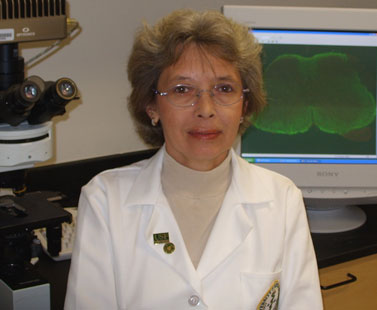Umbilical cord blood cell transplants may help ALS patients

USF neuroscientist Svitlana Garbuzova-Davis and colleagues showed that a moderate dose of HUBC cells proved most effective.
Tampa, FL (June 25, 2008) — A study at the University of South Florida has shown that transplants of mononuclear human umbilical cord blood (MNChUCB) cells may help patients suffering from Amyotrophic Lateral Sclerosis (ALS) or Lou Gehrig’s disease. A disease in which the motor neurons in the spinal cord and brain degenerate, ALS leaves its victims with progressive muscle weakness, paralysis and, finally, respiratory failure three to five years after diagnosis.
In this study, USF researchers transplanted human umbilical cord blood (hUCB) cells into mouse models with ALS. Cells were transplanted at three different dose strength levels — low, moderate and high — to determine the degree to which dose levels of transplanted cells might delay disease symptom progression and increase lifespan.
In results published today online at PloS ONE (Public Library of Science), researchers determined that the moderate-strength dose of HUCB cells was most effective in increasing lifespan and reducing disease progression.
“Our results demonstrate that treatment for ALS with an appropriate dose of MNC hUBC cells may provide a neuroprotective effect for motor neurons through active involvement of these cells in modulating the host immune inflammatory system response,” said the study’s lead author Svitlana Garbuzova-Davis, PhD, DSc, of the Center of Excellence for Aging and Brain Repair at USF.
According to the research team, modulating immune and inflammatory effectors with HUCB cells could have a protective effect on dying motor neurons. The team had previously shown that hUBC cell transplants reduced inflammation and provided neuroprotection in models of stroke and Alzheimer’s disease.
“This pre-clinical study indicates that MNC hUBC cells may protect motor neurons by inhibiting an immune inflammatory response by decreasing pro-inflammatory cytokines, signaling proteins in the brain and spinal cord that play a role in immune response,” Garbuzova-Davis and colleagues wrote. “Proinflammatory cytokines may be indirect mediators for glial cells’ contribution to motoneuron death and the decrease in these cytokines might be due to a reduction of activated microglia, the cells that form active immune defense in the central nervous system.”
The research team noted, however, that the mechanism underlying the beneficial effect of hUBC cells for repairing diseased motor neurons in ALS still needs more clarification.
Suggesting that ‘more is not better,’ it was the moderate, not the high, dose of hUBC cells that proved most effective. Researchers speculated that the high dose may have been less effective because it induced an immunological conflict within the mouse model.
“Future studies should look at multiple injections of smaller doses over time, in order to help translate this research to clinical trials,” according to co-author Paul R. Sanberg, PhD, DSc, director of the center.
“Developing an effective treatment for ALS is complicated by the diffuse nature of motor neuron death,” concluded Garbuzova-Davis. “However, cell therapy may offer a promising new treatment.”
The study was supported by a National Institutes of Health STTR Phase 1 grant. The other co-authors were Cyndy Davis Sanberg and Nicole Kuzmin-Nichols from Saneron CCELL Therapeutics, Inc., and Alison E. Willing, Carmelina Gemma, Paula C. Bickford, Christina Miller, and Robert Rossi from USF.
– USF Health –
USF Health is dedicated to creating a model of health care based on understanding the full spectrum of health. It includes the University of South Florida’s colleges of medicine, nursing, and public health; the schools of biomedical sciences as well as physical therapy & rehabilitation sciences; and the USF Physicians Group. With $308 million in research funding last year, USF is one of the nation’s top 63 public research universities and one of Florida’s top three research universities.
News release by Randy Fillmore

